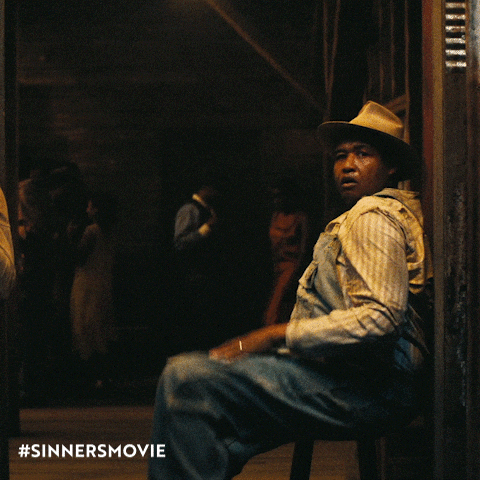- imprompt2
- Posts
- Jump Scares
Jump Scares
Terror already exists inside your reader—you just have to activate it.

For this long-anticipated installment of IMPROMPT2 (Can I pretend we were building suspense?), I want to talk about jump scares.
Sinners isn’t precisely the kind of movie that relies on jump scares, but it has a few interesting ones.
First some context: It’s 1932, and twin brothers Smoke and Stack have just returned to their hometown of Clarkesdale, Mississippi to open a Black-owned, Black-operated, Black-patronized juke joint with fine liquor and even better music. But they face an array of obstacles, including racism, the Klan, the dire economic situation in the town, their own secrets, and the family reputation they will never shake. And one more thing: vampires.
I want to consider the jump scare that occurs just after Cornbread, the doorman, who has been in and out all evening, suddenly wants to be invited back inside. Our heroes aren’t sure what’s going on, but they’re getting suspicious, and they won’t say the words. Then Cornbread demands his pay for the night. Smoke slowly reaches through the doorway to hand him some cash—
And there’s the jump!
—Cornbread grabs Smoke’s arm and tries to bite it. It’s the suddenness that creates the scare, as much as the teeth. But Smoke gets away and Cornbread runs off. No real damage is done.
It’s a fun moment. And it accomplishes a few classic jump scare functions.
First, a jump scare informs or reminds you what kind of story you’re in. Knowing that bad things are definitely going to happen is a huge part of making your spine tingle. Like the creepy music, or the slow approach in a haunted house story, a jump scare is a genre marker that primes you for what is coming.
This particular Sinners jump scare happens relatively late in the film. After all the necessary world-and-theme-and-character building details of getting the joint running, followed by the intrigue and the music of the grand opening, we appreciate the reminder that this is a horror movie.
Second, a good jump scare can release tension. You want to create suspense for your reader/viewer, sure, but you don’t want it to overwhelm or blow up too soon. That’s why a good horror creator keeps careful control of how the fear is building. A false alarm or near miss is like a pressure release valve to keep the reader at the right level of terrified.
So a jump scare can create tingles, can prime us for what’s coming, can keep us precisely on the edge of our seats.
But a jump scare can also give important information about what kind of evil we’re facing.
When Cornbread needs the invitation, then when he attacks, the characters begin to figure out that it’s not regular human evil they’re dealing with, or even haints–it’s vampires. Even if the viewer has already guessed what these monsters are, we need to learn the particular lore at play, since it varies story to story. Wooden stakes? Garlic? Sunshine? And is it still you in there?
Of course, there are plenty of other ways to convey that kind of information. Jump scares are special because they can approach the danger multiple times and from different angles, with each quick glimpse clarifying our sense of the evil, but also drawing out the mystery so that suspense can build.
Horror is necessarily a fleeting emotion. We can build anticipation to draw out the experience, but once the actual worst has happened, fear is displaced by a different emotion, such as grief, or anguish, or possibly resignation.
But a jump scare allows us to approach the monster multiple times, always learning something new, so that the fear can sustain over time. Then, in the final worst moment, we can get an explosion of horror that has accumulated from each of the previous near misses. They layer to create a depth of experience. And they mean that the fleeting climax has extra punch.
This works wonders when the horror is mysterious. Each flash gives us a new new detail about the monster, a new aspect to fear. Even as the thing itself remains mostly in the shadows, a shape emerges. It’s a way of drawing what is intangible and unspeakable.
I think this technique is even more important in prose than in film. Writing makes you take in details one word at a time—instead of getting a whole moving picture with sound. You learn the colors one by one, each tooth described, each splash of blood, each disturbing element. So in order to create an experience of immersive horror that happens in a single climactic moment, you need to put those smaller details in place ahead of time. Jump scares are an opportunity to do that.
They can also build resonance and meaning.
In the case of Sinners, approaching the evil in quick bursts, interspersed with other aspects of the characters’ lives and the other injustices they live through, means that we’re not only learning the basic facts about what these vampires do to you—the horror also accumulates a deeper and more dreadful meaning. The subtext of the story clings to the vampires, and they gain symbolic resonance. It means that the horror is not only a supernatural threat, but part of the world itself, representing larger systems of oppression.
In one encounter, we may learn that it takes a wooden stake to kill a vampire. But in another, we learn that a few of them were literal Klansmen before their turn. In yet another moment, we learn that these demons enslave you within your own body.
So it’s more than a quick fright. It matters.
But there’s one more thing a good jump scare can do. Besides evoking terror or drawing its shape—it can re-situate the horror.
Up until the moment with Cornbread, the characters have been afraid of worldly horrors that are located outside of their bodies and outside of their community. They’re worried about the Klan. They’re worried about those white people who tried to join their party. They have every reason to be worried about these things.
But this encounter is different. Suddenly, the characters have to fear one of their own—the man who was literally trusted to guard their door! The monster has relocated inside their community.
This fear very quickly transfers to someone even closer. Our next jump is when Stack (who was thought to be dead and is already inside the building) wakes up, stabs the door, then bursts through it.

Stack is Smoke’s twin brother. The terror is getting closer and closer to home.
Then we get a further realization of how this evil works—it doesn’t just infiltrate your building, or your community, it gets all the way inside you.
A move like this is common–and very effective–in horror stories. What is far away comes closer. What is outside the body moves inside it.
Now think about the physical reaction that a good jump scare makes happen—not just for the characters, but for the reader or viewer. This story is happening to fictional characters who are distant from me. But when I jump, it’s my body that has jolted. The story has moved inside me.
I think all jump scares do something like that. When the fear reaches through the screen or the page to give the viewer or reader a visceral reaction, one felt in the body and seen by others (as the popcorn flies!), we locate the story in the body.
And that is terrifying.
For Your Consideration:
What about that other kind of jump scare, when it’s not a near miss with the monster—but the cat? A false alarm jump certainly functions as a genre marker and a pressure release valve, priming the reader for what’s to come. But is it otherwise a cheap thrill? What different information might this sort of scare give the reader or viewer? Maybe something the about the nature of the world? Or something important about the character’s preoccupations, fears, and desires? Might it also draw the shape of something mysterious?
From Erin Kate:
That’s a false alarm.
Erin Kate has jump scared herself right into a concussion and needs brain rest, so she’ll be responding—correcting my errors, challenging my ideas, and filling in all the logical holes I’ve left—in a later installment.
Try This:
Consider what your character most fears (it doesn’t have to be a monster), and give them a quick brush with it, but then let them escape. Maybe a vampire grabs their arm and tries to pull them out of a building. Or maybe their mother almost almost broaches a very difficult topic of conversation. See what you can learn from their fear and the shadow it casts.
Don’t use this as an excuse to avoid writing the actual terrifying scene! Write that too! But see if you can intensify that ultimate confrontation by drawing the shape of it first.

IMPROMPT2 is a project of writers Erin Kate Ryan and Allison Wyss.
Reply